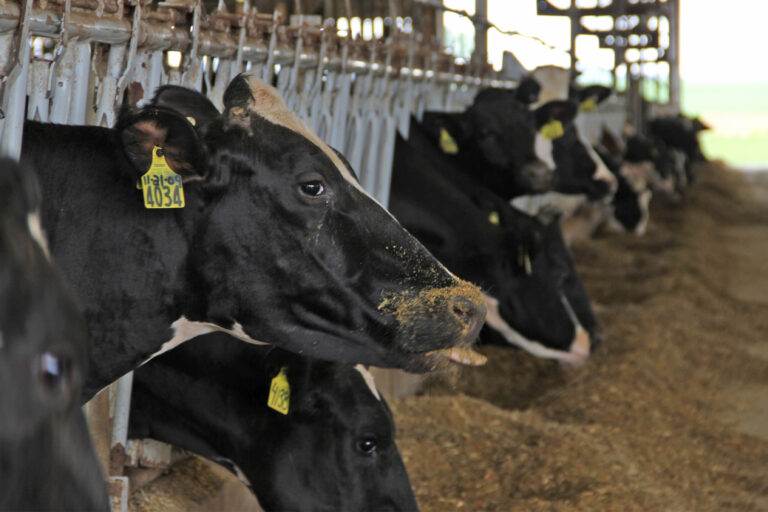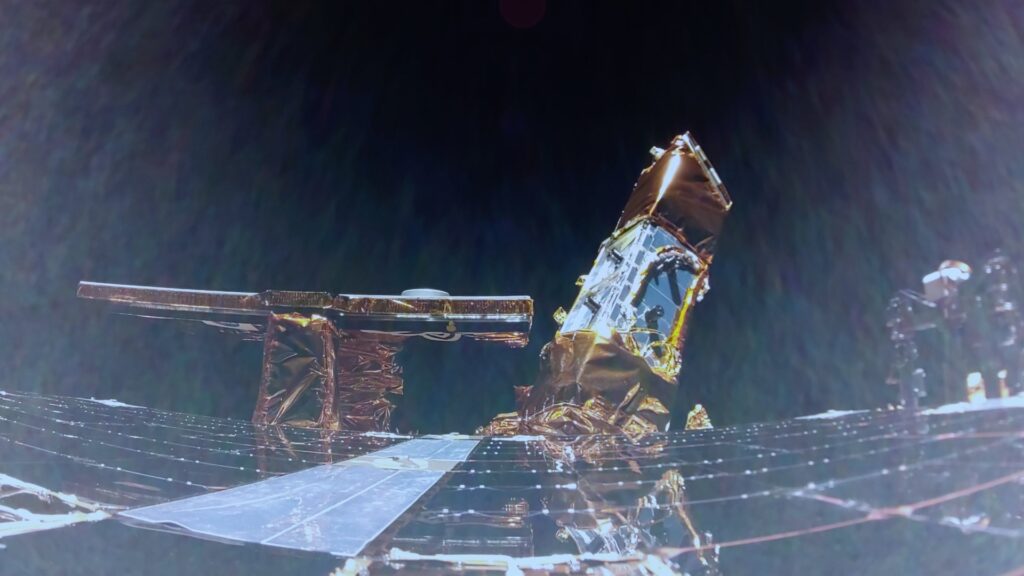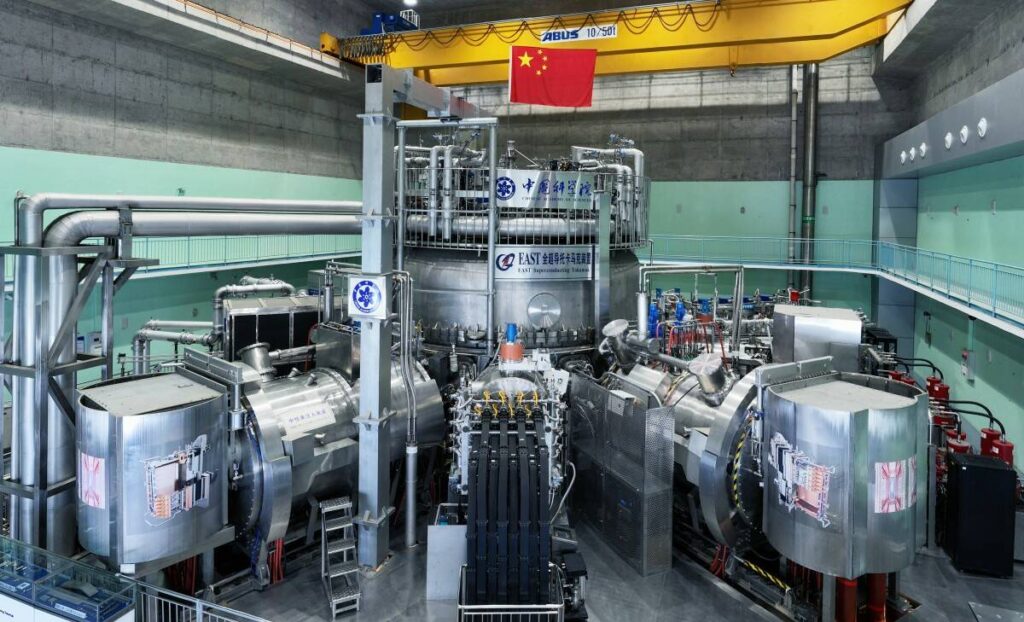Atmospheric methane removal: A promising but challenging climate solution

Technology tamfitronics
- Methane is currently responsible for about one-third of global warming. This greenhouse gas is about 80 times more potent than carbon dioxide in terms of its ability to heat up the climate system, though methane molecules only persist in the atmosphere for seven to 12 years before breaking down.
- Methane emissions are a major cause for concern, as they’ve been increasing at record speeds the past five years. At least two-thirds of annual methane emissions now come from human activities, including livestock, agriculture, fossil fuels, and landfills and other waste. Climate change is also increasing methane releases.
- Removing atmospheric methane is a tempting prospect as a climate change-curbing strategy. Multiple geoengineering approaches are being considered, but research remains limited and largely theoretical, while environmental impacts largely remain unknown and underexplored.
- Researchers say methane removal technologies, such as the iron salt method, should be investigated to break down atmospheric methane molecules. But scientists interviewed for this story repeatedly emphasized the most urgent need is to simultaneously make rapid deep cuts to human-caused methane emissions.
A variety of geoengineering technologies are being closely studied to rapidly remove carbon dioxide from the atmosphere. But researchers are also now considering removing another powerful greenhouse gas: atmospheric methane, or CH4. But no viable technology exists yet to do so at scale.
Methane is a highly potent greenhouse gas, roughly 80 times more powerful than CO2 in its ability to heat up the Earth. It is currently responsible for about a third of annual warming, and for the past five years, civilization has released alarmingly record amounts of methane into the atmosphere.
Today, at least two-thirds of yearly methane emissions come from human activities, including livestock, agriculture, fossil fuels, landfills and other waste — while climate feedbacks add to that total via releases from global wetlands and Arctic permafrost. Researchers emphasize that the quickest fix is to slash human-caused emissions.
But some scientists are considering another approach: Methane is short-lived in the atmosphere, with CH4 molecules breaking down in seven to 12 years, against the 100 or more years it takes CO2 to break down. So scientists are investigating geoengineering technologies that might expedite this methane breakdown and help achieve a cooler world.
“Currently, anthropogenic methane emissions are adding about half a degree Celsius [0.9° Fahrenheit] to warming,” says climate scientist Gabrielle Dreyfus from the U.S.-based Institute For Governance & Sustainable Development. “In theory, combining mitigation measures to reduce [methane] emissions with removal could potentially [eliminate] that warming.”
To that end, the U.S. National Academies of Science in a report this year, chaired by Dreyfus, called for a coordinated research program and funding to investigate various atmospheric methane removal methods.


Technology tamfitronics A global promise to reduce atmospheric methane
In 2021, the EU and U.S. led the world in making the Global Methane Pledge to slash methane emissions by 30% by 2030. That pledge has now been take up by 158 nations. Though still early days, global CH4 emissions show no signs of slowing.
Similar to actions to curb CO2 emissions, global efforts to slash methane emissions are far from where they need to be. A 2023 study found that only 13% of emissions were covered by mitigation policies.
Earlier this year, researchers published the Global Methane Budget, warning of the continued record rise of emissions, with “CH4 as the second most important human-influenced greenhouse gas in terms of climate forcing after carbon dioxide.”
There are many solutions that could rein in methane emissions, including the reduction of flaring at oil and gas wells, and even feeding the world’s 3 billion cattle (the leading agricultural source) red seaweed to curb their methane-rich farts.
But some researchers stress these approaches may not be sufficient, and they are working on geoengineering fixes that might be deployed in future to stave off the worst impacts of climate change.
That being said, the science of atmospheric methane removal (AMR) is still in the “very early and novel concept” stages, and is far behind carbon dioxide removal research, says Dreyfus. “The earliest reference that we found [in the scientific literature] to the concept of methane removal, especially in a climate context, was 2010.
“The top line recommendation from the [2024 Global Methane Budget] report is that we need to do research to answer some very fundamental questions to be able to improve our understanding.”

Technology tamfitronics The methane removal challenge
Atmospheric methane removal researchers are exploring a range of technological approaches. These include methane reactors and concentrators (working somewhat like carbon capture technologies); surface treatments (to catalyze methane); ecosystem uptake enhancement (to provoke natural systems to destroy methane); and atmospheric aerosol enhancement (the release of particles into the air to break down atmospheric methane).
All these techniques aim to break down methane into CO2a far less potent greenhouse gas. “Methane in the atmosphere naturally reacts to form CO2 [in seven to 12 years]. So, these technologies would just be accelerating that process,” explains Dreyfus.
Each of these technologies is accompanied by difficult “research questions that need to be answered if you want to assess their efficacy and the potential impacts and consequences,” she adds.
Methane’s chemistry makes scrubbing it from the air challenging. First off, CH4 is far more dilute in the atmosphere than CO2and it reacts in very different ways, says Matthew Stanley Johnson, a chemistry professor at the University of Copenhagen. Carbon dioxide dissolves in water, can stick to an absorbent, or be converted into a salt, providing various removal routes; that’s not possible with methane.
“It just bounces right off the surface of a catalyst. You need a very active catalyst to do something with methane,” Johnson explains. “The number of tools we have at present is limited, and we need more technologies to come online.”
Consequently, a technology gap exists, according to the National Academies report. Currently “no commercial mitigation technologies oxidize methane at concentrations below 1,000 parts per million (ppm), even though most methane emissions are found at concentrations closer to 2 ppm in the atmosphere.”
That is no longer technically true, according to Johnson, who is also chief scientist with Ambient Carbon, a private company. His firm recently developed methane reactor technology that has proved effective at very low concentrations. However, that tech is designed primarily to tackle point-source methane emissions, such as cattle barns, not atmospheric methane.


Technology tamfitronics Calling on plants for help
Other scientists hope to tackle the methane problem by harnessing the power of nature. Research published this year shows how forests can play an important role in breaking down atmospheric methane on a global scale.
That’s due to the presence in tree bark of methane-eating microorganisms known as methanotrophs. These are also present in soils, another major methane sink. Scientists wonder if they can prompt these natural processes to heighten their roles as sinks. What exactly that would look like is unclear and study is ongoing, but Dreyfus calls it a “very interesting” prospect.
“Ecosystem uptake enhancement” would use “known amendments or practices that can enhance net uptake of methane, either by making those methane eating microbes happier, or [by] suppressing the generation of methane,” she says, adding that managed lands such as croplands or plantations could be targeted for implementation.
Vincent Gauci, a professor at the University of Birmingham, U.K., who led research on the capacity of trees as a methane sink, is supportive of the push to research ecosystem uptake enhancement and other atmospheric methane removal techniques.
In his view, a potential “win” might be found by enhancing commercial forestry by selecting for trees primed to convert more methane, or simply by reforesting large areas and letting nature do its work. But he emphasizes that it is still early in such research.
“There are many different approaches that could all be leading into augmenting methane uptake by trees and forests,” Gauci says. But he cautions that “we have to tread carefully here in terms of how we treat natural ecosystems. I think what the lesson of the trees tells us is that that there are potential wins from small changes to large scale but diffuse methane sinks that could be enhanced.”

Technology tamfitronics The iron salt method
Another technique that has received research attention is atmospheric aerosol enhancement. The theory suggests that a mass release of particles, such as iron salts, into the atmosphere could catalyze methane aloft, breaking it down.
The technique, known as atmospheric oxidation enhancement, would try to replicate a natural process that occurs when Sahara Desert dust storms blow out over the Atlantic Ocean. As the dust collides with sea salt spray, chemical reactions naturally occur, breaking down atmospheric methane.
Iron salts added to the atmosphere could mimic this natural process and release reactive chlorine which could break down methane, leaving behind carbon dioxide and water vapor.
Over 100 million metric tons of iron are released into the atmosphere via natural processes annually, which reduces just 2% of atmospheric methane, explains Natalie Mahowald, a geoscientist at Cornell University whose group is studying the iron salt method.
Some proposals to ramp up that natural process, or “enhance” it, include large numbers of planes or ships spraying huge volumes of iron salt molecules into the air.
But that’s no easy feat as initial research suggests that the release of an additional 100 million metric tons of molecular chlorine would be needed to significantly reduce atmospheric methane. “We emit about 30 [million metric tons] per year of black carbon today, [so] we’re talking about adding massive amounts of iron aerosols to even start to make a dent,” explains Mahowald.
There are a couple of other snags: First off, chlorine is toxic. Also, releasing so much chlorine would likely break down ozone before it broke down methane, so the whole process could actually worsen the methane problem if not done correctly and carefully, say experts. That’s because ozone is also responsible for creating the hydroxyl radical that oxidizes methane in the first place; removing it could therefore inadvertently lengthen the lifespan of atmospheric methane.

Reducing ground-level ozone, a significant cause of air pollution, could be a public health win, but Mahowald says the technique could also exacerbate air pollution in some regions, while there are concerns too that it could affect stratospheric ozone and set back the progress of the Montreal Protocol that protects Earth from harmful levels of ultraviolet radiation.
Research conducted by Johnson’s group and others, however, suggests that, if done correctly and in the right place, the iron salt technique could work safely and efficiently. Areas with high anthropogenic air pollution would be wrong for such a project and, notably, so would high-traffic shipping lanes. Optimal areas would likely be in the Southern Hemisphere.
Atmospheric aerosol enhancement’s potential and risk bring up multiple questions that only further research can address. But it also gives rise to numerous governance concerns similar to those facing other geoengineering techniques such as solar radiation modification, which could offer another major roadblock. A case in point: While the Southern Hemisphere could be optimal scientifically for iron-salt deployment, many African nations have already expressed strong opposition to all geoengineering.
Bennu, a U.S.-based company previously known as Blue Dot Climate, investigated the iron-salt method with the aim of deploying iron salt from ships at sea, but has since pivoted to a different, far smaller-scale approach. Permission was granted for a field test, but this didn’t occur, says company founder David Henkel-Wallace.
Another company, Switzerland-based Atmospheric Methane Removal, is currently researching the technique, with the idea of dispersing iron salts from a fleet of planes. According to co-founder Oswald Petersen, the firm is in the development phase, raising funds to build a prototype dispersal technology. “We have the design, but we don’t have the money to actually build it. The second step is to do a field test,” Petersen says, adding that any future experiments will be subject to environmental impact assessments.
“There’s some evidence that [iron salt] might work and maybe there’s a way to make it much more efficient,” Mahowald says, adding that she remains highly skeptical. “There is much more proof that is needed before we should allow implementation of the iron salt method to reduce methane.”
Johnson agrees, adding “we need to proceed very carefully” and build knowledge through modeling before any future controlled testing. “So far, I haven’t seen evidence that would kill the idea,” he says.

Technology tamfitronics A methane-free future?
The National Academies report recommends a focused research agenda spanning three to five years with millions of dollars in funding allocated to a deep dive into questions raised by each methane removal technology stream.
Importantly, few of those research questions would require field testing or deployment. “These are all things that can be assessed with lab or modeling type analysis,” says Dreyfus. Only in the case of ecosystem uptake enhancement are some small-scale field tests envisaged.
Dreyfus adds that development of methane removal technologies should go hand in hand with governance discussions, to avoid thorny public controversies, such as those arising from solar radiation modification field tests.
“Emerging technologies like methane removal touch on both social and technical dimensions,” she says. “It’s very important that at the inception of these research programs that those [issues] be integrated at the beginning.”
With the field in its infancy, it may be years before methane removal reaches maturity, and some techniques may never do so. Either way, this line of study has benefits, according to David Mann, co-founder of Spark Climate Solutions, a nonprofit that has funded various strands of methane removal research.
“Regardless of whether or not atmospheric methane removal ends up taking place at scale, this [early] research is valuable in that it will also advance our scientific understanding of methane dynamics, the climate, and our ecological system,” Mann says.
Jackson agrees that basic methane removal research could be productive and benefit other mitigation technologies. He emphasizes, however, that humanity’s focus should first be on slashing emissions and then, if “absolutely necessary,” on developing methane removal technologies — science that will likely be more expensive and challenging than cutting emissions at their source.
“We don’t need methane removal,” he says. “If we could get our act together and reduce emissions [now] or in the next few years, all the additional 3 billion tons of methane in the atmosphere today from human activity would disappear in 10 or 12 years.”
Banner image: A U.S. dairy farm. Global methane emissions have increased rapidly over the past five years. Human-caused sources originate with livestock, agriculture, fossil fuels, landfills and other waste. Image by Steve Droter/Chesapeake Bay Program via Flickr (CC BY-NC 2.0).
CO2 in, methane out? Study highlights complexity of coastal carbon sinks
Citations:
Jackson, R. B., Saunois, M., Martinez, A., Canadell, J. G., Yu, X., Li, M., … Patra, P. K. (2024). Human activities now fuel two-thirds of global methane emissions. Environmental Research Letters, 19(10), 101002. doi:10.1088/1748-9326/ad6463
Pennacchio, L., Mikkelsen, M. K., Krogsbøll, M., Van Herpen, M., & Johnson, M. S. (2024). Physical and practical constraints on atmospheric methane removal technologies. Environmental Research Letters, 19(10), 104058. doi:10.1088/1748-9326/ad7041
Olczak, M., Piebalgs, A., & Balcombe, P. (2023). A global review of methane policies reveals that only 13% of emissions are covered with unclear effectiveness. One Earth, 6(5), 519-535. doi:10.1016/j.oneear.2023.04.009
Saunois, M., Martinez, A., Poulter, B., Zhang, Z., Raymond, P., Regnier, P., … Zhuang, Q. (2024). Global Methane Budget 2000-2020. doi:10.5194/essd-2024-115
National Academies of Sciences, Engineering, and Medicine. 2024. A Research Agenda Toward Atmospheric Methane Removal. Washington, DC: The National Academies Press. doi:10.17226/27157
Nisbet-Jones, P. B., Fernandez, J. M., Fisher, R. E., France, J. L., Lowry, D., Waltham, D. A., … Nisbet, E. G. (2021). Is the destruction or removal of atmospheric methane a worthwhile option? Philosophical Transactions of the Royal Society A: Mathematical, Physical and Engineering Sciences, 380(2215). doi:10.1098/rsta.2021.0108
Jackson, R.B., Abernethy, S., Canadell, J.G., Cargnello, M., Davis, S.J., Féron, S., … Zickfeld, K. (2021). Atmospheric methane removal: A research agenda. Philosophical Transactions of the Royal Society A: Mathematical, Physical and Engineering Science, 379(2210). doi:10.1098/rsta.2020.0454
Krogsbøll, M., Russell, H. S., & Johnson, M. S. (2023). A high efficiency gas phase photoreactor for eradication of methane from low-concentration sources. Environmental Research Letters, 19(1), 014017. doi:10.1088/1748-9326/ad0e33
Gauci, V., Pangala, S. R., Shenkin, A., Barba, J., Bastviken, D., Figueiredo, V., … Malhi, Y. (2024). Global atmospheric methane uptake by upland tree woody surfaces. Nature, 631(8022), 796-800. doi:10.1038/s41586-024-07592-w
Jeffrey, L. C., Maher, D. T., Chiri, E., Leung, P. M., Nauer, P. A., Arndt, S. K., … Johnston, S. G. (2020). Bark-dwelling methanotrophic bacteria decrease methane emissions from trees. Nature Communications, 12(1). doi:10.1038/s41467-021-22333-7
Ming, T., de Richter, R., Dietrich Oeste, F., Tulip, R., & Caillol, S. (2021). A nature-based negative emissions technology able to remove atmospheric methane and other greenhouse gases. Atmospheric Pollution Research, 12(5), 101035. doi:10.1016/j.apr.2021.02.017
Van Herpen, M. M., Li, Q., Saiz-Lopez, A., Liisberg, J. B., Röckmann, T., Cuevas, C. A., … Johnson, M. S. (2023). Photocatalytic chlorine atom production on mineral dust–sea spray aerosols over the North Atlantic. Proceedings of the National Academy of Sciences, 120(31). doi:10.1073/pnas.2303974120
Li, Q., Meidan, D., Hess, P., Añel, J. A., Cuevas, C. A., Doney, S., … Saiz-Lopez, A. (2023). Global environmental implications of atmospheric methane removal through chlorine-mediated chemistry-climate interactions. Nature Communications, 14(1). doi:10.1038/s41467-023-39794-7
FEEDBACK: Use this form to send a message to the author of this post. If you want to post a public comment, you can do that at the bottom of the page.
Discover more from Tamfis Nigeria Lmited
Subscribe to get the latest posts sent to your email.



 Hot Deals
Hot Deals Shopfinish
Shopfinish Shop
Shop Appliances
Appliances Babies & Kids
Babies & Kids Best Selling
Best Selling Books
Books Consumer Electronics
Consumer Electronics Furniture
Furniture Home & Kitchen
Home & Kitchen Jewelry
Jewelry Luxury & Beauty
Luxury & Beauty Shoes
Shoes Training & Certifications
Training & Certifications Wears & Clothings
Wears & Clothings
















